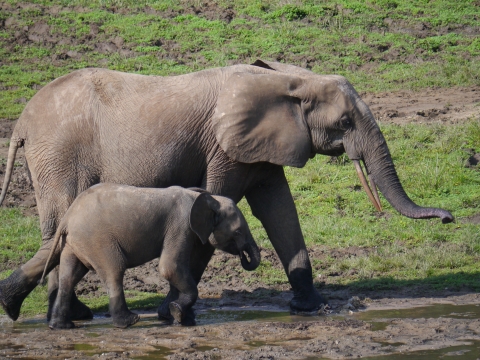Elephants, rhinos, tigers, great apes, and marine turtles have long captivated the hearts of Americans. As with all of the U.S. Fish and Wildlife Service’s conservation efforts, partnerships are key to their conservation success. For more than 30 years, the U.S. Fish and Wildlife Service’s International Affairs Program has worked with partners around the world to protect iconic and lesser-known species and the habitats they depend on, and to strengthen capacity to more effectively address conservation threats.
Demonstrating that our efforts are having an impact is also central to the Service‘s work. International Affairs staff determine the positive impact of our funding on wildlife conservation through grantee reporting and site visits but have been looking for a systematic, evidence-based methodology to demonstrate our impact more broadly.
The Green Status of Species, a new approach to understanding species recovery and conservation impact, may help. Spearheaded by the International Union for Conservation of Nature (IUCN), this tool creates a global standard to measure the recovery of plants and animals and assess the impact of conservation efforts. Complementary to the IUCN Red List, which documents decline, the Green Status of Species will help to inform and incentivize future conservation actions.
“The IUCN Red List tells us how close a species is to extinction but is not intended to paint a full picture of its status and functioning within its ecosystem,” says Molly Grace, lead author of a paper laying out the framework for the Green Status of Species and co-chair of the IUCN’s Green Status of Species Working Group. “With the IUCN Green Status, we now have a complementary tool that allows us to track species recovery and dramatically improve our understanding of the state of the world’s wildlife. The IUCN Green Status of Species provides evidence that conservation works, giving cause for optimism and impetus for stronger action.”
Lucy Keith Diagne, executive director of the African Aquatic Animal Fund and a longtime partner of the Service’s International Affairs Program, is pleased that the African manatee was one of the first species chosen for analysis. “Most conservation efforts for the African manatee are relatively recent,” she says. “It’s important to see the potential effect of current and future conservation efforts versus what the future for the species would be without conservation. It’s a powerful message that conservation is working.”
Bibhab Kumar Talukdar, chair of the IUCN/Species Survival Commission’s Asian Rhino Specialist Group, CEO of the non-governmental conservation organization Aaranyak, and longtime partner of the Service on Asian rhino conservation, describes being involved in global efforts on the Green Status of Species as a privilege. “I focused on the Sumatran rhino, which is a critically endangered species and currently only found in Sumatra, Indonesia. I feel that Green List of Species is useful when stakeholders need to see the value of conservation action to date and in the future and share a common vision for species recovery.”
How might the Service employ the methods used by the Green Status of Species and an increasing number of our species conservation partners in foreign countries? In combination with other methods, our International Affairs Program is currently testing how the Green Status standard can inform grant-making decisions to achieve program goals with the highest return on investment for wildlife conservation. Matt Muir, the Service’s Evaluation Officer in the Division of International Conservation, says “The Green Status of Species is helping reframe how the global conservation community thinks and talks about the collective impact of our work. Our programs are adapting, exploring how the Service can improve how our foreign assistance is monitored and evaluated, and testing procedures that are practical and feasible for our partners. Stay tuned for more to come!”



